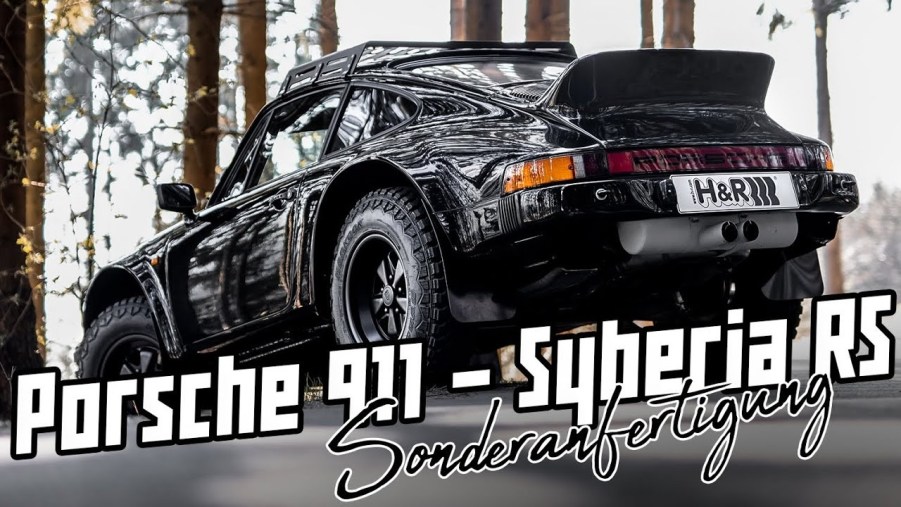
The Porsche 911 Syberia RS: When a Hummer Is Too Slow
As air-cooled Porsche 911s have risen in popularity—and price—so too have alternative takes on the typical hyper-restored build. One of these is the Safari 911, which sees the German sports car turn into a genuine rally replica. The trend is now so popular, well-known Porsche tuners are starting to get involved. And the Safari idea has even spread to other cars, like the Mazda Miata. The Porsche 911 Syberia RS, though, goes a little bit further than some other Safari builds.
Porsche 911 Syberia RS build background

Truth be told, a lifted 911 isn’t exactly a Hummer H1 when it comes to off-roading and rock-crawling. However, an H1 in un-restored form is crude and fairly slow. That was the main problem, Autoblog reports, German car enthusiast Kai Burkhard had with the military-based SUV.
But, if a Porsche 911 doesn’t have the same ground clearance as a Hummer, it does still have an impressive off-pavement history. Before the all-wheel-drive 959 supercar debuted, 911s competed in multiple rallies. In fact, the 959’s AWD system was tested in a 911 rally car, the 1984 953, Hagerty reports. Said car, incidentally, would win that year’s Paris-Dakar outright. Thus, knowing about Safari 911s and the car’s rally history, Burkhard chose a 1986 911 as the base for his off-road build.

But, the 911 isn’t the only Porsche with rally experience. When the Cayenne SUV first debuted, the automaker proved its off-road chops by sending it on the 4,400-mile Transsyberia Rally. Across Russia and the Mongolian steppes, a Cayenne won the 2007 race. And in 2008, the top 6 finishers were all Porsche Cayennes.
That ‘Syberia’ in ‘Transsyberia’ is what gives Burkhard’s Porsche 911 Syberia RS its name.
Specs and features
To build the Porsche 911 Syberia RS, Burkhard worked with the Tailor-Made one-off department of German suspension company H&R. It’s not known, Auto Classics reports if the modifications included engine tuning. However, the rest of the 1986 911 was extensively modified.
The wheel wells were cut and fender flares added to fit Hankook DynaPro Mud Terrain tires, which were originally designed for trucks. The 911 also received a roof rack, 2 hood-mounted rally lights, a new bumper with integrated winch and tow hooks, as well as a new rear spoiler and custom central-exist exhaust. Inside are Recaro sport seats, a roll cage, Momo steering wheel, as well as numerous bits of Alcantara.
But the most extensive modifications, naturally, are underneath. The Porsche 911 Syberia RS got short-ratio gears, and a limited-slip differential. H&R completely redid the suspension, which included re-locating the suspension mounts. The 911 now rides on a custom fully-adjustable coil-over setup, with the chassis reinforced to handle high-speed jumps. Auto Classics reports the H&R mods have been so well-received, the company’s getting requests from other 911 owners to install similar parts.
Syberia RS vs. other Safari Porsche 911 builds
Burkhard’s Porsche 911 Syberia RS, at least for the time being, is just a one-off. Other companies, though, can build you a Safari 911.
Arguably the one that started the trend was The Keen Project’s Leh Keen. The Smoking Tire’s Matt Farrah owns one of Keen’s Safari builds. Like the Syberia, Keen’s builds are purely rear-wheel drive.

German tuner RUF has recently unveiled a Safari-style concept called the Rodeo. However, while it looks like a 911, it’s actually built on RUF’s own carbon-fiber chassis. Unlike Burkhard’s or Keen’s, it has AWD. But, at the moment, it’s just a concept.
Former Singer fabricator T.J. Russell has also started building Safari Porsche 911s. Russell’s builds, though, are expressly designed for racing. To start, instead of just a roll cage, the Russell Built Fabrications car gets reinforced throughout by a custom tube frame. And The Drive reports Russell does modify the stock engine.
Now we just need to see if any owners decide to send their Safari 911s to the actual Paris-Dakar.
Follow more updates from MotorBiscuit on our Facebook page.


